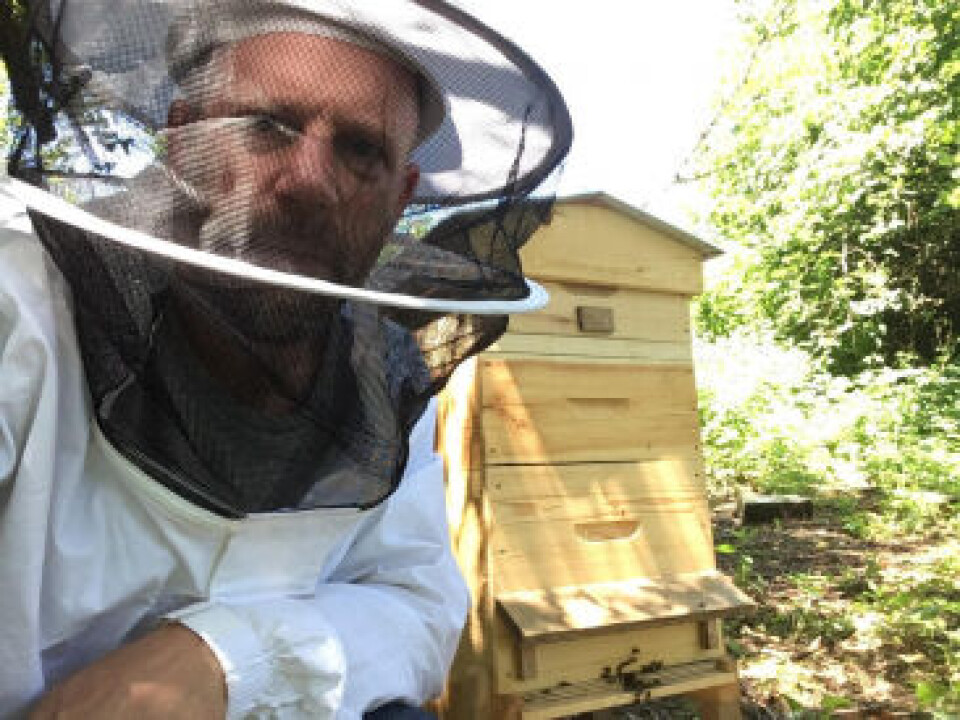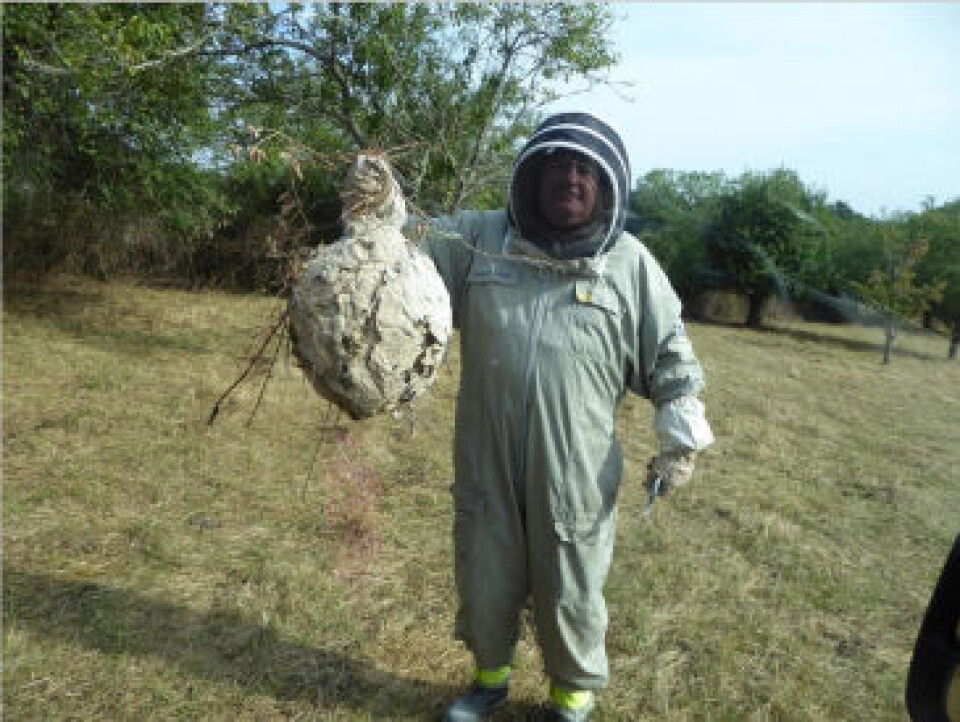-
The origins and meaning of tirer les marrons du feu
As Christmas approaches, we look at a phrase to describe someone who takes advantage of a situation
-
How to identify lounging lizards in France
Learn about the habitats and behaviours of diverse lizard species, from the common wall lizard to the elusive Western three-toed skink
-
The origins and long history of France’s unique wildlife officers
Connexion talks to Julien Nicolas, who fulfils a role created by Charlemagne in the year 803, tackling wildlife posing a danger to the public
‘No stings yet!’: Feedback from beekeeping beginners in France
Readers share their motivations and varied experiences of installing hives in their gardens

Fran and Phil Bevan, who moved to France in 2016, signing to buy their property and gite business in the north of Ariège department on the day before the Brexit referendum result, have just bought their first hive and swarm of bees.
They decided to take the decision after talking to friends who have hives, and with the encouragement of Fran’s cousin in Australia, who is a beekeeper.
He proved to be useful, when the couple had a slight mix-up and realised that their bees, instead of being delivered to them, had to be collected.
“I messaged him in a bit of a panic to ask what we needed,” said Fran.
“He explained about the small travelling hives that are used and so it was yet another trip to the bee co-operative where we visited in March, April, and May, buying equipment for the travelling hive.”
‘Doing things in real is so much different’
The couple had trained themselves mainly through books, online courses and YouTube videos due to Covid, but managed to go to one training day organised by the co-operative.
“That was really good – doing things in real is so much different from only reading or watching about it,” said Fran.

They bought their swarm in early June from a bee breeder, who, with everyone suited up, took them to some of his hives, opened one and moved frames of bees into the travelling hive.
Any which fell off the hives, then crawled into the hive over the next half hour, to be with the queen.
Fran and Phil then took the travelling hive, with a belt over the top to stop in opening, and foam in the holes in the bottom, home in their car with the seatbelt around it, and put it next to the large hive they bought.
After giving the bees a couple of days to settle, they transferred them to the larger hive.
“We have not been stung yet and the bees seem to be docile and tame,” said Fran.
“The bee breeder knew we were beginners and I think he selected a swarm bred for ease of handling.”
When sunflowers came into flower near them, they opened an upper part to see if the bees would make extra honey but by the last week of July they had not done so.
“They are busy in the lower section with pollen and honey and I think the first year we will not get much,” said Fran.
“It is important to let the hive grow and for it to have enough of its own honey to help it through the winter.”
As with any new livestock, the couple often go down to look at how things are going.
“We open the hive up to have a look and it is fascinating to see how it all works. Otherwise I sit to the side and just watch them come and go,” said Fran.
Interview 2: ‘You get to recognise the bees’ moods’
Simon and Nicola Mason moved to the Creuse two years ago, and bought bee hives and a swarm in May.
They put the bees in a hive next to some woodland they own, as far from the house as possible, and enjoy watching the activity.
Drama occurred when they saw a swarm leave the hive – swarms occur when a queen bred in the hive is ready to leave and form their own colony.
“Luckily we were outside and saw the swarm which started to move away,” said Simon.

“We tried to follow it but it moved too fast and so we lost them, which was disappointing, but then the next day a new swarm left and this time we followed it and were able to capture it and put it in a new hive. It is too early yet to say if it will be successful but the signs are good.
From the outside we can see bees taking pollen in and they look purposeful, which sounds funny to people who do not keep bees but when you do you recognise their different moods.”
Simon’s parents kept bees, but this is the first time he has. Their son Alex is studying entomology (the study of insects) at university and the bees are a common interest for the family when he comes home during holidays.
Interview 3: ‘The honey from semi-wild bees is excellent’
Pest controller Robert Moon, who operates his business applicateur3D, from a base in Cher department in the centre of France, used to give away the swarms of bees he was called out to capture – until one of the beekeepers asked why he was not keeping them himself.
“I could not give a good reason, so I kept the next swarm I captured, and have gone on from there,” he said.
“Now I have three hives and a honey harvest which can be as much as 50kg from two harvests a year – although in 2019 it was too hot and we did not get any.”
He said he is very much in the “leave alone” school of beekeeping, only usually opening the hives twice a year to harvest.
“This has the disadvantage of the bees not being so used to disturbance and they get pretty angry when you open the hive, but I also believe that if you leave them alone rather than treating and fussing over them, you have a better chance of ending up with bees with a natural resistance to disease. Plus the honey from semi-wild bees is excellent.”
The “leave-alone” and the “open every week” schools of beekeeping in France each defend their corner with vigour, he has found.

His interest in bees, and his job as a pest controller, including removing Asian hornet and European hornet nests, led him to the British bee suit makers “BBwear”.
In addition to normal suits, they make the expensive, very protective “Ultra Bee Suit”.
“I have worn it while being attacked by angry hornets and did not get stung, and have not been stung while harvesting honey while wearing it either,” said Robert.
“There is nothing similar I have seen in France, so I made contact with them and am now the French distributor for the Ultra Bee Suit. It is a business spin off from what is an enjoyable hobby for me.”
His advice for people who have bee swarms near the house is to try and get someone to move them as quickly as possible, before they move into roofs, walls or chimneys.
“Once they do they are almost impossible to get out alive without spending thousands of euros,” he said.
Interview 4: ‘An explosion of wildlife’
Planting wild flower meadows for his bees in a field near the river Blavet in Morbihan department led to an explosion of wildlife which really surprised Steve Maile.
“The field, which is about four hectares, used to be cut for hay, but we decided we would try and encourage some more wildflowers so we ploughed it up a bit and put down seed, mainly a wild clover mix from a local farm supply place, used as a green manure by farmers,” he said.
“I also got a big bag of wildflower mix off the internet.
“The result was stunning – I went out there in the mornings when all the flowers were out and there was so much insect noise, I could not figure out what it was for a while. As well as the honey bees, there were wild bees of many sorts, butterflies and little flies and even dragonflies which flew in from the river to feed on the other insects.”
Steve used to keep bees in the UK and has noticed some differences, mainly in the type of hives used.
“The basic principles are the same though,” he said.
His swarms are of the British Buckfast breed, which is also popular in France because the bees are usually calm and good producers.
‘We once had a swarm of wild bees but they did not settle’
“We once had a swarm of wild bees which we captured and put in a hive, but they remained angry and did not settle,” he said.
“The next day they swarmed again and went into a tree, and I thought I would try again with them but they were so aggressive, I let them go,” he said. “I think they might have been the famous black bees – there are some left in Brittany.”
With six hives he hopes to produce around 250 half litre pots of honey a year, which he sells to a market trader.
“The taxes and social charges involved were a bit of a shock, but it helps cover the costs of equipment and a bit extra,” he said.
His wife Debra, used to help with the hives but stopped after being stung a couple of times.
She now helps with the after-harvest tasks like getting the honey out of the combs and potting it up.
Steve’s hive seem to be doing very well this year, in spite of the wet weather, which he puts down to the wild flowers, and also to a new anti-varroa mite treatment based on the synthetic pyrethroid Fluvalinate, he used last autumn.
“I tried some other treatments other years which did not seem to do much and which involved opening the hives,” he said.
“But this one went in for a month and the test strips showing how many mites were killed were full. I think it is one of the reasons the bees seem so strong this year and I recommend it to other beekeepers.”
Related stories:
Is there space in your French garden for hives in return for honey?
























